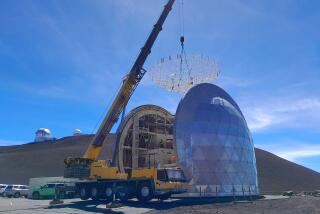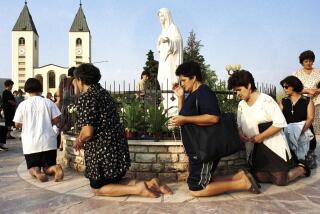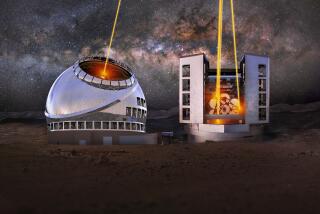Vatican’s Stargazers Place Faith in Science
CASTEL GANDOLFO, Italy — As the pope slept downstairs, Brother Guy Consolmagno maneuvered the viewing deck into position, stopping when he reached the massive telescope pointing heavenward through the open ceiling.
“Anyone see Mars?” he asked the four off-duty Swiss Guards standing around him. They strained to find the bright spot that had poked out from behind the clouds just moments before.
“Ah, yes, perfect. There it is,” Consolmagno said from behind the eyepiece. “Not bad, all in all.”
It was just before midnight on a Friday at Castel Gandolfo, Pope John Paul II’s lakeside summer residence and the home of the Vatican Observatory. The Swiss Guards had the night off, and Consolmagno, 50, a Jesuit astronomer from Detroit, had invited them up to the viewing deck to gaze at something they won’t see again in their lifetime.
All this month, Mars is closer to Earth than at any time in the last 60,000 years, shining brighter than any other celestial body except the moon and Venus. On Wednesday, at its nearest, Mars will be 34.6 million miles from Earth -- and won’t be that close again until Aug. 28, 2287.
All of which means lots of nighttime viewing activity for the pope’s stargazers -- the Jesuits who run the observatory and who have battled to correct the notion, spawned by the Galileo affair nearly 400 years ago, that the Roman Catholic Church is hostile to science.
The Vatican Observatory, founded by Pope Leo XIII in 1891, is one of their prime exhibits, generating top-notch research from its scientist-clerics and drawing academics to its meteorite collection, which includes bits of Mars and is considered among the world’s best.
“Simply by being an astronomer and a Jesuit, I’m saying all I need to say about science and religion,” Consolmagno, a meteorite specialist, said. He wore a T-shirt with a star chart for his stargazing, but changed into clerical garb for an interview and photos.
“The fact that I exist means there is obviously no conflict. The fact that the Vatican is paying for this first-class research means they don’t see any conflict.”
But 400 years ago, there was plenty of conflict.
Galileo Galilei (1564-1642) made the first complete astronomical telescope and used it to gather evidence that the Earth revolved around the sun. Church teaching at the time placed Earth at the center of the universe.
The church denounced Galileo’s theory as dangerous to the faith, but Galileo defied its warnings. Tried as a heretic in 1633 and forced to recant, he was sentenced to life imprisonment, later changed to house arrest.
The Galileo affair gained mythical proportions in the late 19th century when authors such as Andrew White, the first president of Cornell University, wrote about the “warfare” between theology and science, arguing that religion was an obstacle to the triumph of scientific progress.
In reality, the Catholic Church had a long history of supporting science, particularly astronomy, said Father Sabino Maffeo, the retired director of the Castel Gandolfo observatory and author of “In the Service of Nine Popes: 100 Years of the Vatican Observatory.”
As early as the 1500s, Pope Gregory XIII and mathematicians made solar observations that confirmed predictions about the equinoxes in the Gregorian reform of the calendar, he wrote.
Starting in the 1700s, the papacy established three early observatories in and around Rome. In the mid-1800s, a Jesuit priest, Father Angelo Secchi, became the first person to classify stars according to their spectra, the book says.
Pope John Paul II himself has been a keen supporter of the modern Vatican Observatory, although he hasn’t been able to use the big telescopes for several years because of his infirmities, Consolmagno said.
A year after he became pontiff in 1978, John Paul created a commission to review Galileo’s condemnation. After the commission reported back, John Paul declared in 1992 that the ruling against Galileo was an error resulting from “tragic mutual incomprehension.”
A year later the Vatican Advanced Technology Telescope was dedicated on Mt. Graham, 75 miles east of Tucson. It has been used for observations ranging from galaxy structure to stellar evolution.
Consolmagno says the Vatican has come a long way since the Galileo debacle, establishing first-rate science departments at Catholic universities and constantly updating its observatory, which for many years was in Vatican City itself.
In the 1930s, it moved to Castel Gandolfo, in the Alban Hills about 15 miles southeast of the capital, because Rome’s city lights were getting too bright. It was an ironic choice of venue, considering that the papal villa was built by Urban VIII, during whose papacy Galileo was tried.
But eventually Rome’s lights encroached on Castel Gandolfo too, hence the choice of Arizona for the new telescope.
Some of the 12 scientists attached to the observatory work there, while others remain at Castel Gandolfo, doing research on meteorites or processing data from the Arizona telescope.
“The perspective of the church is clearly changed since those times,” said James W. Head III, a professor of planetary geoscience at Brown University. “It’s not at all incongruous to be exploring the wonders of the cosmos as part of an official Vatican scientific thing.”
The Vatican scientists are “up there with world-class science and exploration,” he said.
Head says he was particularly struck by the human perspective John Paul gave to space exploration when he received scientists, including Head, a non-Catholic, who presented their findings from NASA’s Galileo mission to Jupiter and its satellites.
The pope, Head recalled, spoke about “how further exploration really opens up beyond our simple views here to the wonders of the cosmos and what we don’t know.”
Indeed, Consolmagno says the hunger for the unknown that inspires astronomers is the same “transcendent yearning” for God that theologians speak about.
Today, Consolmagno says, the church’s main challenge is not to persuade scientists that there is nothing wrong with religion, but “to convince religious people that there’s nothing wrong with science” -- a reference to the evolution debate in the United States and elsewhere.
Such lofty issues were not on the minds of the Swiss Guards up on the viewing deck when they got a rare close-up look at Mars and its icecap, as well as a magnified glimpse of the moon, pockmarks and all.
“I’ll be able to tell my grandchildren I saw Mars,” said one who declined, in keeping with Vatican rules, to give his name. “You could see the details. Molto bello.”
More to Read
Sign up for Essential California
The most important California stories and recommendations in your inbox every morning.
You may occasionally receive promotional content from the Los Angeles Times.









